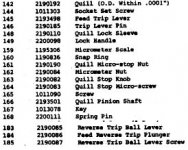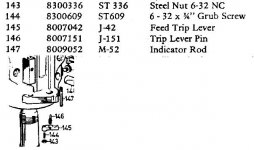jto52
Plastic
- Joined
- Dec 2, 2001
- Location
- Florida USA
I have been scouring the machinist's message boards looking for someone who has faced the problem of a seized Bridgeport quill but so far I haven't found anything. I am hoping that some of the Bridgeport experts on this forum can help. I apologize for the length of this post but I am trying to include all of the details.
I recently acquired a 1955 vintage Bridgeport Mill with a J head on the cylindrical ram. The previous owner assured me that it was operational six months earlier when he acquired it from a local boat builder that went out of business. He had let it sit outside under a leaky tarp so some water did get to it. I have been disassembling it to bring it back to operation to at least a hobbyist level. (I am using the Ilion manual as a guide.)
In taking the head apart many of the parts have been stiff and difficult to remove, but liberally spraying it with B'laster has mostly loosened things up so that not a lot of force has been required. I have seen a little rust (primarily on the casting), but there seems to be a lot of "gunk" which is likely dried grease, oil, and dirt that became like paste when the rain water got to it. Once the parts I have removed so far are cleaned they work smoothly together.
The big problem with this machine (so far!) is the the quill is jammed at its uppermost position. Additionally, the spindle doesn't turn. I presumed when I acquired the machine that the bearings would be shot so the spindle not turning isn't too troublesome but the fact that the quill is stuck is causing a lot of difficulties. The fact that the quill is fully retracted means that I can't access the set screw that secures the quill nose piece, so the spindle cannot be slipped out the bottom of the housing. I have removed the clock spring and everything on the handle end of the pinion shaft and I can see the pinion gear and the teeth on the quill that engage the gear. While there is some rust on the casting, the pinion and the quill look fairly clean. On the other end of the shaft I have removed everything up to the worm gear/clutch ring. I don't know if there is a problem in the pinion/quill area (although I can't see anything that looks suspicious), but I am very hesitant to try to force the pinion shaft and gear past the quill. I may be able to remove the worm gear/clutch ring with the pinion shaft still in place but I don't know if that will help any. The double set screw holding the pinion bushing has been removed, however. Is attempting to drive out the pinion shaft something I should pursue or is this a bad idea? I have removed the quill lock shaft and lock shoes and the quill in this area also looks clean (no rust but a little grime that wiped off easily with a paper towel).
Additionally, I cannot remove the quill stop screw because the reverse trip ball lever is stuck and is a bit cockeyed in the hole. It sort of looks like the trip level plunger is sticking up a little and is blocking the reverse trip ball lever in. It's hard to tell. The quill stop knob blocks the view of the bottom of the trip level plunger. Is this merely a symptom of the quill being stuck or is it possibly the cause? Threading a 4-40 screw into the reverse trip ball lever and pulling on it doesn't help because the reverse trip ball lever is too cockeyed and jammed to come out. If the quill wasn't stuck I could perhaps jiggle the reverse trip ball lever to remove it. Again, I have been hesitant to try and force anything.
At the top of the quill I have removed the two screws. (The felt oil strainer was missing.) Are the screw holes actually in the top of the quill? I can see the spindle lock washer but I have no way to remove it while its down inside the quill housing. I did bend down the tab on the bearing lock washer and I tried tapping with a punch on the ears of the spindle lock washer but I didn't achieve anything because the angle of the punch was too acute.
My approach so far has been to assume that the quill is stuck because of grime and gunk so I am soaking it in a tub of B'laster. I am looking for possible other solutions to this problem. I have not tried heat or tapping on the top of the spindle and I won't until advised otherwise.
Any suggestions are appreciated.
I recently acquired a 1955 vintage Bridgeport Mill with a J head on the cylindrical ram. The previous owner assured me that it was operational six months earlier when he acquired it from a local boat builder that went out of business. He had let it sit outside under a leaky tarp so some water did get to it. I have been disassembling it to bring it back to operation to at least a hobbyist level. (I am using the Ilion manual as a guide.)
In taking the head apart many of the parts have been stiff and difficult to remove, but liberally spraying it with B'laster has mostly loosened things up so that not a lot of force has been required. I have seen a little rust (primarily on the casting), but there seems to be a lot of "gunk" which is likely dried grease, oil, and dirt that became like paste when the rain water got to it. Once the parts I have removed so far are cleaned they work smoothly together.
The big problem with this machine (so far!) is the the quill is jammed at its uppermost position. Additionally, the spindle doesn't turn. I presumed when I acquired the machine that the bearings would be shot so the spindle not turning isn't too troublesome but the fact that the quill is stuck is causing a lot of difficulties. The fact that the quill is fully retracted means that I can't access the set screw that secures the quill nose piece, so the spindle cannot be slipped out the bottom of the housing. I have removed the clock spring and everything on the handle end of the pinion shaft and I can see the pinion gear and the teeth on the quill that engage the gear. While there is some rust on the casting, the pinion and the quill look fairly clean. On the other end of the shaft I have removed everything up to the worm gear/clutch ring. I don't know if there is a problem in the pinion/quill area (although I can't see anything that looks suspicious), but I am very hesitant to try to force the pinion shaft and gear past the quill. I may be able to remove the worm gear/clutch ring with the pinion shaft still in place but I don't know if that will help any. The double set screw holding the pinion bushing has been removed, however. Is attempting to drive out the pinion shaft something I should pursue or is this a bad idea? I have removed the quill lock shaft and lock shoes and the quill in this area also looks clean (no rust but a little grime that wiped off easily with a paper towel).
Additionally, I cannot remove the quill stop screw because the reverse trip ball lever is stuck and is a bit cockeyed in the hole. It sort of looks like the trip level plunger is sticking up a little and is blocking the reverse trip ball lever in. It's hard to tell. The quill stop knob blocks the view of the bottom of the trip level plunger. Is this merely a symptom of the quill being stuck or is it possibly the cause? Threading a 4-40 screw into the reverse trip ball lever and pulling on it doesn't help because the reverse trip ball lever is too cockeyed and jammed to come out. If the quill wasn't stuck I could perhaps jiggle the reverse trip ball lever to remove it. Again, I have been hesitant to try and force anything.
At the top of the quill I have removed the two screws. (The felt oil strainer was missing.) Are the screw holes actually in the top of the quill? I can see the spindle lock washer but I have no way to remove it while its down inside the quill housing. I did bend down the tab on the bearing lock washer and I tried tapping with a punch on the ears of the spindle lock washer but I didn't achieve anything because the angle of the punch was too acute.
My approach so far has been to assume that the quill is stuck because of grime and gunk so I am soaking it in a tub of B'laster. I am looking for possible other solutions to this problem. I have not tried heat or tapping on the top of the spindle and I won't until advised otherwise.
Any suggestions are appreciated.














